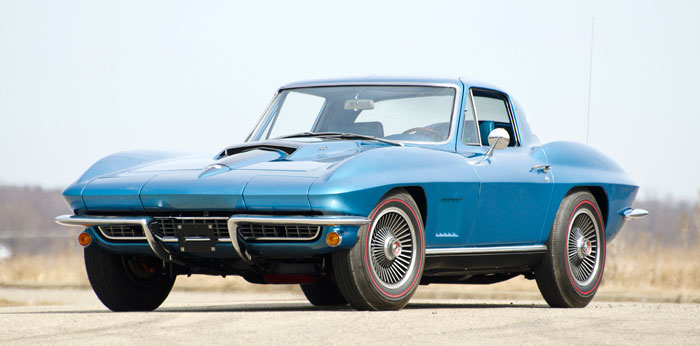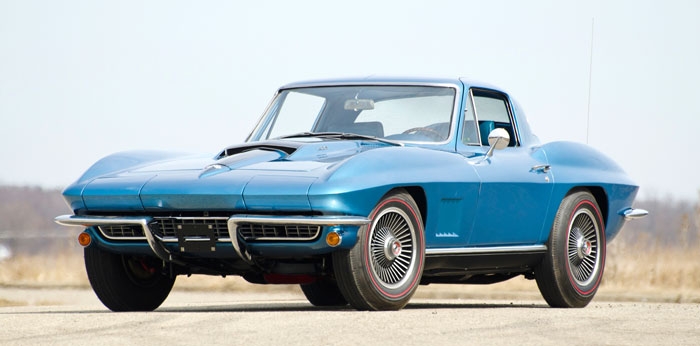
- 4-speed
- L89 aluminum heads
- Transistor ignition
- F41 suspension
- 4.11 Positraction
- AM/FM radio
- Multiple NCRS Top Flight award winner
- Bloomington Gold certified
- Owner’s manual
{auto}1609{/auto}
SCM Analysis
Detailing
| Vehicle: | 1967 Corvette L89 427/435 Coupe |
| Years Produced: | 1967 |
| Number Produced: | 16 with L89 option |
| Original List Price: | $5,704.40 (as equipped) |
| SCM Valuation: | $240,000-$340,000 |
| Tune Up Cost: | $400–$500 (3x2 induction tuning) |
| Distributor Caps: | N |
| Chassis Number Location: | Passenger-side dash under glove box on structural support |
| Engine Number Location: | Pad on passenger side of engine forward of cylinder head |
| Club Info: | National Corvette Restorers Society |
| Website: | www.ncrs.org |
| Alternatives: | 1966 Corvette 427/425 L72 1963 Corvette 327/360 Z06 1967 Corvette 427/435 L71 |
| Investment Grade: | N |
This car, Lot T232, sold for $124,020, including buyer’s premium, at the Mecum auction in Indianapolis, IN, on Thursday, May 19, 2011.
In 1967, Chevrolet introduced the new L71 option for the 427-ci V8. This would include Tri-Power carburetion and a mostly underrated 435 horses to plaster a guy into his bucket seats.
Along with the new L71 option, one could also check the box for the all-new aluminum cylinder heads. This would be known as the Regular Production Order (RPO) L89 configuration. To get it, buyers needed to check the box for the L71 option and then top it off with the L89 heads, which added an additional $805.75 to the base price. These two options alone ratcheted up the MSRP to $5,194.50—without any other options checked off.
For deep-pocket Corvette buyers, the overall cost was not that much of a factor. It was a lot of car for the money—one that could smoke just about anything on the road and be welcome at the local country club. It was a stylish brute, to say the least.
But, in 1967, if a guy was going to pony up for more ponies, he wanted real performance—not an upgrade that technically produced the same horses as the L71.
By the spec books, the L89 engine was still rated at 435 horsepower—the same as the L71 engine—even though the aluminum heads had larger exhaust valves than their iron-head counterparts. The $368.65 L89 option added an additional cost, but for the uninitiated buyer, no discernable increase in bragging rights at the local pub.
The real value for adding aluminum heads back then—and today—is for weight savings. The L89 option shaved about 75 pounds off the front wheels. The performance value comes from the power-to-weight ratio—if you’re moving less weight, you can move an object faster with the same amount of energy. Despite this weight reduction, only 16 buyers checked the L89 box, as most buyers probably figured it was easier and less expensive to just kick your buddy out the door if you wanted to max out the driving experience.
Rare but easy to fake
Only 16 L89s were ordered, according to widely published data, which makes our subject car vastly rare—subject to verification. As this is the age of the Internet, where everybody gets to be an expert, the Corvette blogs and forums have been ablaze with comments pro and con about this car. I can’t tell you whether these wired pundits are right or wrong, but I can report on the reasons behind the discussions.
Part of what makes the L89s so rare is also what makes them so easy to fake. Get some correct, vintage aluminum heads and creatively stamp the engine with the proper codes, and, all of a sudden, you have a rare L89 that could potentially pass muster in high-profile judged events (guys, don’t shoot me, it happens and we all know it).
As I have stated in previous articles, the big money being spent for these cars means some disreputable guys have gotten really good at creating nearly indiscernible fakes.
Again, I’m not suggesting that our subject car is either genuine or an imposter, but I wish there had been concrete documentation presented with the car that verified that this was an air-tight, authenticated, born-with, rock-solid L89. Personally, I would have liked to have seen a tank sticker, bills of sale, P.O.P. and some original dealer documents to help substantiate the car. Some—or all—of these papers would have helped.
A rock-solid ownership trail would also aid in decoding the DNA of the car.
As we’re talking about one of 16, not one of 1,600, I’d be super picky about asking for iron-clad proof before I’d pry any greenbacks out of my wallet.
If the seller did have some or all of these documents, I’d say he left a thick stack of hundred-dollar bills on the table by not presenting them at the sale – it’s really that simple.
A judged Corvette
The Mecum description describes chassis 13522 as a recipient of multiple NCRS Top Flight awards and Bloomington Gold certification. However, keep in mind that these respected judging bodies are not in the business of proclaiming a car to be a genuine, factory-built L89, only that it is typical of what came off the 1967 Corvette assembly line.
That judging includes whether the car is correct with all the proper codes, stampings and components as seen on the factory build.
Market analysis
After all that we’ve said above, chassis 113522 was either remarkably well bought or somewhat well sold. Our dissection really comes down to authenticity. If the car was the real deal—one of the original 16 L89 cars built by Chevrolet—then I’d say bravo to the buyer for a well-done and colossally well-bought car. The CM Pocket Price Guide doesn’t even mention the L89, as the values of these ultra-rare Corvettes are simply a wild guess.
Yes, we can take the L71 values and ramp them up, but with only 16 L89s built, you simply don’t see these cars trade hands very often in a public forum. We could use L88s as an example, as only 20 of those were built in 1967—but those are vastly different machines, and you can’t buy one for $124k. The CM Pocket Price Guide values 1967 L88s at $1.2m to $2m.
At $124,020, the price of our subject car was even somewhat light on the Corvette-O-Meter for even an “ordinary” L71 coupe given the straight-up #2 condition of the car and the previously mentioned awards from NCRS and Bloomington Gold.
Money with a message
I believe that the money paid here directly shows that buyers had questions about the authenticity of the car. It has been suggested that airtight documentation could have ramped the bid up at least two-fold, which is only an educated guess—but I don’t have any reasons to doubt that claim.
Documentation for a one-of-16 Corvette is vital—and I would suggest mandatory for any buyer who is deciding how to best invest his hard-earned moola on an investment-grade Corvette. I believe that most of the buyers in the room came to the same conclusion, and they had deep concerns about the real-deal status of the car.
Bigger money for this car will stay deeply implanted in buyer’s wallets—until such time that more documentation surfaces about the original build
